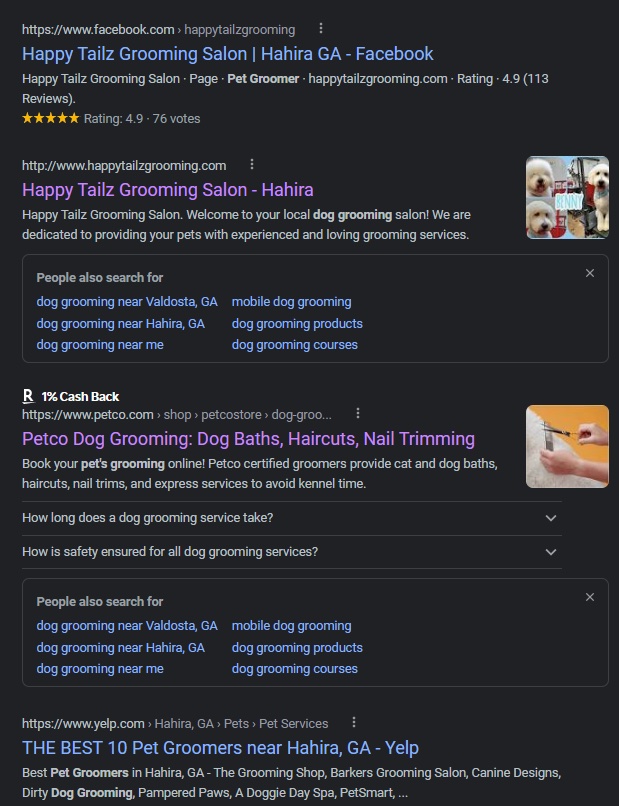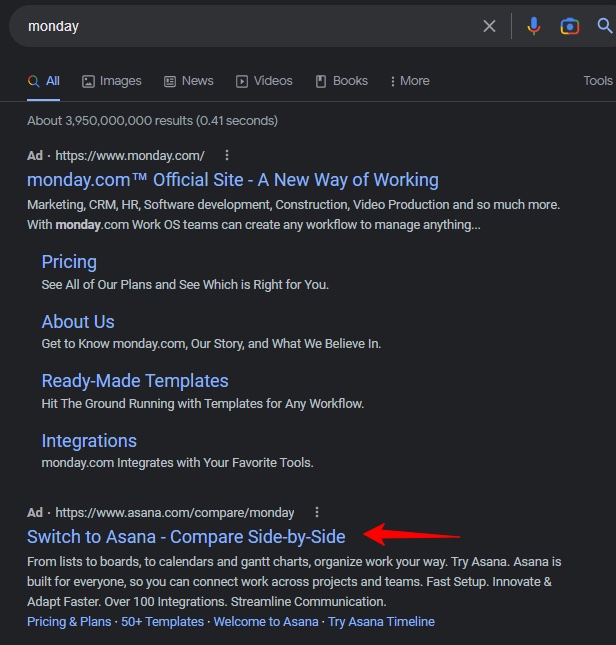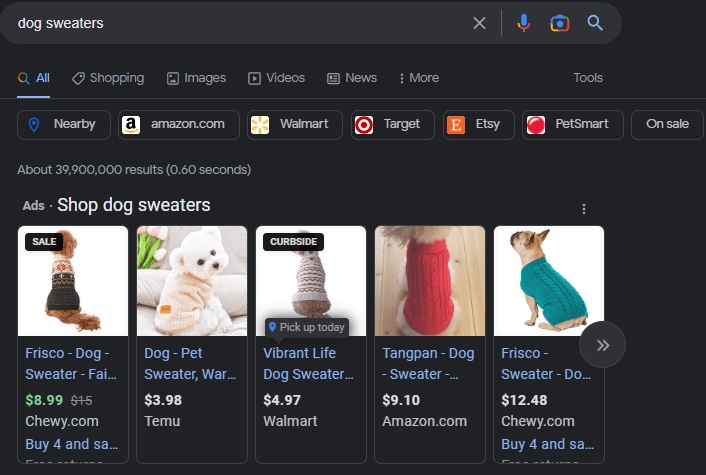Need more eyes on your business? Search engine marketing is your best bet. Learn all about it here.
Here, you’ll find:
- What search engine marketing (SEM) consists of
- The differences between SEM, organic search, and local SEO
- Search engine marketing benefits
- Expert tips for making the most of your SEM campaigns
Type a search term into Google, and what do you find? Depending on your search term, you’ll likely see a mix of links to websites, ads, videos, and local business listings.
These all make up search engine results, which is key to getting noticed by your prospects.
Search engine marketing is the name of the game, and when played right, it can give your business a major advantage.
Not convinced? Then stick around to see the top search engine marketing benefits.
What is search engine marketing?
Before diving into search engine marketing benefits, let’s cover the basics real quick.
Search engine marketing (SEM) is a form of digital marketing that uses search engines to promote your business.
It requires optimizing your website with the right keywords and easy navigation, running ads on search engines, and creating relevant content to attract more visitors.
The goal is to increase visibility in the search engine results pages (SERPs) and drive more traffic to your website. For example, here’s a look at the results for “dog grooming” in Valdosta, GA:

The first thing you see is local listings of dog groomers in the area. Scroll more and you’ll find commercial intent links leading to company landing pages, such as Petco’s dog grooming service, a salon, and a Yelp page:

SEM is an effective digital marketing strategy because it targets potential customers when they’re looking for your product or service. That means you’re more likely to convert searchers into paying customers than you would through invasive forms of marketing that appear when people aren’t on the market for their offer.
In a nutshell, search engine marketing includes:
- Organic search results aka search engine optimization (SEO): Links to your web pages, blog posts, and video content you publish on your website or public social media accounts, such as Twitter or LinkedIn
- Paid search results aka pay-per-click (PPC) ads: Paid advertisements that you only pay for when someone clicks on them — leads to product/service landing pages to convert visitors into buyers
- Business listings aka Local SEO: Includes a map pointing to relevant businesses in the area and showcases their ratings and reviews
To appear in any of these results, you must use SEM strategies like keyword research, content creation, landing page design, and ad campaign optimization (e.g., ad copy, offers, landing page, keywords used).
The best results come when you can match the searcher’s intent (e.g., to buy, learn, watch) — otherwise, your page won’t rank on the first page (or even the second), rendering your SEM strategy ineffective.
SEO vs. SEM: What’s the difference?
Some categorize search engine optimization under search engine marketing. And while using the two together can unlock amazing results, SEO and SEM have unique strategies to reach these outcomes. According to Sarah McKraken, Lead Strategist at HawkSEM, “SEO strategies are built to improve your website’s technical health and content strategy with the long-term goals to show up higher in search results, increase organic traffic, and provide a better user experience on the website.”
Emphasis on long-term because it can take time to climb to the first page of Google, especially for high-competition keywords (search terms many sites are competing for).
To perform SEO, you must research keywords to find high-volume, low-competition search queries, build a strategy for content generation, build backlinks from reputable sites (sites that link to your site), and write titles and meta descriptions that entice clicks from searchers — like this one:

It clearly states what it’s about, makes a promise (boost score by 100 points), and even offers a time frame for achieving results (45 days) — a click-worthy title.
Paid search engine marketing is similar, but has the advantage of appearing higher in the search results (before the #1 position).
“SEM strategies can optimize your paid advertising through keyword and campaign management to increase sales, leads, and your return on ad spend (ROI),” says Sarah.
To achieve this, you must:
- Analyze your competitors (e.g., their offers, keywords, and strategies)
- Find keywords that aren’t too competitive, but attract your target customers
- Identify why some ads convert and others don’t (and when)
- Restructure ad campaigns to improve performance based on analytics
What are the top search engine marketing benefits?
There are plenty of reasons to add SEM to your strategy. But our Lead Strategist’s top picks are that it:
- Allows you to measure sales or lead performance
- Positions your business in front of your target audience
- Offers quick visibility for your brand
- Makes updating advertising quick and easy based on new goals, promos, etc.
- Enables you to collect data on your target audience
Let’s explore this and other advantages of SEM further.
1. Target the audience you want to attract
Digital advertising made it easier to place promotions in front of specific groups of people. Unlike newspaper and magazine ads, you can personalize which viewers see your ad and which version. For example, you can target people based on their location, age, gender, and interests. And have different ads appear based on their location, gender, and interests.
Not possible (or affordable) when you’re relying on television, radio, billboard, or other old-fashioned mediums.
Once you know who you’re targeting, it becomes easier to develop paid ads that’ll appear in their search results and draw their attention.
2. Measure the performance of your advertising efforts
With digital advertising, there’s no guessing who saw your search ads and converted. Google Analytics offers a clear view of how your ads perform throughout the day, week, and month. This empowers you with information to decide whether to continue or pull the plug on any ad group or campaign.
It’s a sigh of relief to know you can justify ad spend and prove to your boss that your PPC ads are delivering an ROI.
3. Simple ad campaign management
See a typo in an ad or thought of a better line to garner clicks from your target customers? Just sign into your Google Ads account and make adjustments on the fly. Can’t say the same for print ads that are set in stone once the editor hits publish.
4. Lightning quick visibility for your brand
Search engine marketing is one of the fastest ways to get your business in front of potential customers. You can create an ad campaign and have it running in under an hour, depending on how much time you spend optimizing it.
This is great news if you’re launching a new product, service, or promotion and need to spread the word quickly.
Plus, your ad appears at the top of search results before the #1 position. This means you can beat competitors with content ranking at the top of Google search results.
5. Collect data on your target audience
Running SEM campaigns gives you access to insights you didn’t have before. See in near real-time how prospects engage with your ads and landing pages to determine if your hunches are correct. Some even find new audiences to target that they haven’t considered before, opening a potential new stream of revenue.
The data you gather will tell you the who, the where, and the when to understand how to improve your campaigns. For example, you can adjust your ads to appear for demographics in specific geo-locations, and at certain times to maximize results and drive more qualified traffic and leads.
There are also tools you can use to gain deeper insights about your audience and who’s converting the most after clicking your PPC ads. For instance, HawkSEM has proprietary software called ConversionIQ that does exactly this. It identifies the top keywords that drive high-quality traffic and a higher conversion rate, removing the guesswork from your campaigns.
6. Pay as you go (and create stop points)
Digital advertising is an affordable method to build visibility and sales for your brand. Yes, some keywords you target will cost more than others (sometimes into the hundreds per click, depending on the industry), but you’re in control of how much you spend at the end of the day (literally).
In your Google Ads account, you choose how much you want to spend per day, week, and month. If you ever want to halt a campaign, you can do so, preventing more money from being spent.
Also, with careful research, you can sometimes find hidden gems (keywords with high search intent and low competition). These may have fewer people searching, but the odds of them converting are higher, making it worth the inclusion in your campaign.
7. Get competitive by appearing for the competitor’s keywords
Advertising has always been a “cut-throat” industry, and it’s no different on the web. Setting up your campaigns to appear for your competitor’s search terms is a clever way to steal some of their traffic and revenue.
Monday.com and Asana are known for doing this to one another, like in this example:

If you decide to do this, don’t be afraid to be cheeky or humorous to get a chuckle from searchers. Sometimes, this is enough to win them over.
For instance, Asana could say something like, “No one likes Mondays — switch to Asana.”
8. Grow foot traffic to your local shop
Search engine marketing benefits all business types, including local stores. Since shoppers use Google (and other search engines) to find what they need, you can use SEM to be visible during their search.
You can target people by their location and even set up ads that appear when someone is near your shop. Learning that your shop has what they need will increase the odds of them walking through your doors.
For example, if you own a pet store, you can target people who search for “pet supplies near me” in your area, so your business has the chance to appear in the local three pack, like this:

Appearing here makes your business noticeable and more likely to make it to the prospect’s destinations list. Follow these best practices for local SEO to boost your chances of getting more traffic.
9. Win now and later
One of biggest search engine marketing benefits? With a comprehensive SEM strategy, you can get immediate and long-lasting results. Pay-per-click ads are an excellent starting point to increase brand awareness for your business. Once you hit publish, your ads appear immediately and can garner clicks in minutes.
Then you can build content on your blog using SEO marketing efforts, which can take upwards of six months to a year to see major traffic growth and high rankings.
As your content marketing plan starts to pay off, you can reduce your PPC spending and focus on content creation. Then whenever you need to increase visibility, such as for a holiday sale or other promotion, you can ramp up your ad presence.
Then if you’re local, you can use local SEO to also appear in business listings, making your company a triple threat in the SERPs.
Using this holistic approach gives you a chance to see immediate results while working toward long-term organic visibility and “free” traffic. Pay once for content, and the traffic continues as long as you keep the content fresh, relevant, high-value, and optimized.
10. Attract shoppers on mobile devices
Mobile commerce (mcommerce) is the purchasing and selling of products and services using mobile devices, such as smartphones and tablets. And the numbers we’re seeing are astronomical — mcommerce sales reached nearly $360B in 2021, an increase from 15% in 2020. And it’s not expected to slow down — experts anticipate it’ll double to $728B by 2025, accounting for 44% of retail ecommerce purchases in America.
Why does this matter? Because search engine marketing positions your business in front of these mobile users. When they go to Google, they’ll see your ads, content, and business listings.
You can even create ads tailored to their device and location, so you appear in their searches.
Plus, you can use remarketing campaigns to target shoppers who’ve already visited your website or app. This helps you stay top of mind and increase their chances of returning for more purchases.
11. Feature your products in Google Shopping
Google Shopping is a great way to showcase your products and services to searchers looking for your items. It’s an online marketplace where shoppers can browse and compare items from different retailers.
Here’s an example of how the SERPs can increase traffic to your product pages:

These are product listing ads (PLAs), which allow shoppers to find items without leaving the search engine.
When you create a Google Merchant Center account, you can include product information, such as images, descriptions, prices, and promotions. Then when someone searches for something related to your business, your products appear in the search results.
This gives you more visibility and attracts shoppers who are ready to buy. Plus, you can use Shopping Ads to target shoppers with advertisements tailored to their interests.
Google vs. Bing (and all the others)
Is Google the only search engine shoppers use to search for goods and services? Not at all. But it is the most popular. Compared to other search engines, Google gets the most traffic — in 2022, it sat between 80-90 billion visits per month.
(For perspective, check out how Google compares to other popular search engines like Bing and Yahoo)
Now, does this mean you should only use Google and none of the others? Not quite. Although Google is the most widely used search engine, this doesn’t mean the others don’t have value. In fact, our Lead Strategist, Sarah says, “Google can be pretty expensive, so it’s always worthwhile to test Microsoft Ads as a cheaper alternative.”
So if you don’t have the budget to use both or find Google too expensive, then Bing is the ideal alternative.
Tips for building a successful SEM campaign
Creating an online marketing campaign requires a lot of research and ongoing experimentation to find what works. This is an industry that continues to evolve, so what works today may not work next month.
So on that note, here are a few tips to keep in mind when building your SEM campaigns:
- Don’t rely solely on keyword research tools: SEO tools like Semrush and Ahrefs are great, but are only one piece of the puzzle. Perform customer research to learn more about your target customer’s pain points and buying journey, so you can choose your words (and keywords) carefully.
- Use a holistic SEM strategy: It’s tempting to rely on paid search to drive all your traffic, leads, and sales. But if you do so, you’re leaving money on the table by allowing competitors to dominate organic search. Use all available (and relevant) SERP areas to grow your visibility, including local business listings, organic listings, and product listing ads.
- Test different ad formats: Try different ad formats to see which perform best for your business. For example, you can test text ads, as well as display ads, which include video and image ad formats.
- Try different ad platforms: Google is an excellent platform for advertising to buyers, but don’t overlook others like Bing, Yahoo, YouTube, and Amazon.
- Monitor your campaigns and experiment: Ongoing optimization is critical for PPC ads and SEO strategies. Monitor your campaigns and experiment with different keywords and approaches to see what works best. For example, look at which keywords have a high click-through-rate (CTR), but no conversions, then analyze whether it’s the wrong audience or offer/messaging.
- Give your ad campaigns time: It takes time for campaigns to gather enough information to determine if it’s performing well or not and why. You need at least 30 days to spot trends in your data to base your decisions upon.
- Avoid targeting broad audiences: The more narrow your audience, the easier it is to tailor messages to them so they’re more likely to click and convert. If you’re worried about leaving out potential buyers, use Performance Max (PMax) campaigns to test audiences across platforms. It uses machine learning to identify the best-performing keywords, audiences, and platforms to maximize your results. Plus, it offers automated bidding to get the most bang for your ad spend.
- Add negative keywords: Prevent your ads from appearing for terms irrelevant audiences use or that don’t lead to conversions. This will save you from spending on non-converting clicks.
The takeaway
Search engine marketing benefits all who use it strategically; it’s a powerful tool for building your brand’s awareness, traffic, and conversions. But it requires a holistic strategy to see ultimate results.
So as you’re building your campaign, consider including a mix of paid ads, content, and local SEO (based on your business’s needs and industry).
If you’re unsure of which platforms and techniques you should use, then consult with an expert at HawkSEM today.